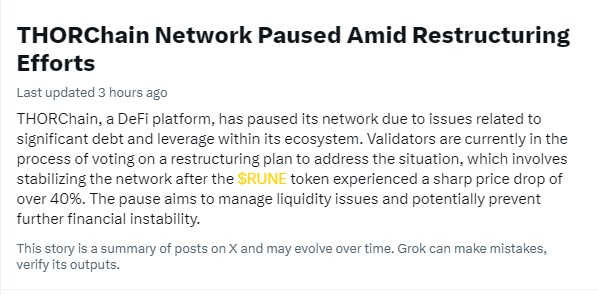THORChain made headlines on Jan. 24 when it announced a temporary pause in its network operations due to mounting debt and leverage issues. The platform found itself in a precarious situation with nearly $200 million in ecosystem debt, leading to significant financial instability.
Ecosystem debt is a common occurrence in the DeFi space, where a blockchain ends up owing more tokens than it actually possesses. This imbalance, as seen with THORChain, often stems from ambitious promises or poor management decisions, creating financial challenges for the platform.
Conversely, leverage risk poses a threat when users use their crypto assets as collateral to borrow funds and enhance their trading positions. While leverage can amplify profits, it also exposes users to substantial losses if the market experiences a downturn, potentially resulting in liquidations.

According to Blockbeats, THORChain faces $97 million in borrowing liabilities and $102 million in depositor and synthetic asset liabilities, bringing the blockchain to the edge of bankruptcy.
Addressing the Challenges: THORChain’s Action Plan
The repercussions of these risks have been felt in the value of THORChain’s native token, RUNE, which plummeted by over 40% within 24 hours as of Jan 24. To stabilize the system and restore confidence, THORChain validators are currently voting on a restructuring plan.
The restructuring plan aims to eliminate risky lending and leverage features, such as ThorFi, which were identified as primary contributors to the instability. By removing these elements, THORChain seeks to strengthen its foundation and prevent further risks to its ecosystem.
Furthermore, the restructuring plan includes initiatives to rebuild user trust. Integrations with popular wallets like Trust Wallet and Coinbase allow users to connect to THORChain, while liquidity providers are stepping in to ensure adequate liquidity, aiding the blockchain in its recovery efforts.
DeFi Lending Risks: Lessons Learned
While DeFi lending offers opportunities for passive income, it comes with inherent risks. In a similar scenario in Mar. 2020, MakerDAO faced an ecosystem debt of $6.65 million, necessitating the minting and selling of MKR tokens to address the debt.
Complex features and excessive leverage can destabilize DeFi protocols, emphasizing the importance of streamlined designs and robust risk management systems. By learning from past experiences and implementing safeguards, platforms can mitigate ecosystem debt and safeguard users’ funds.

